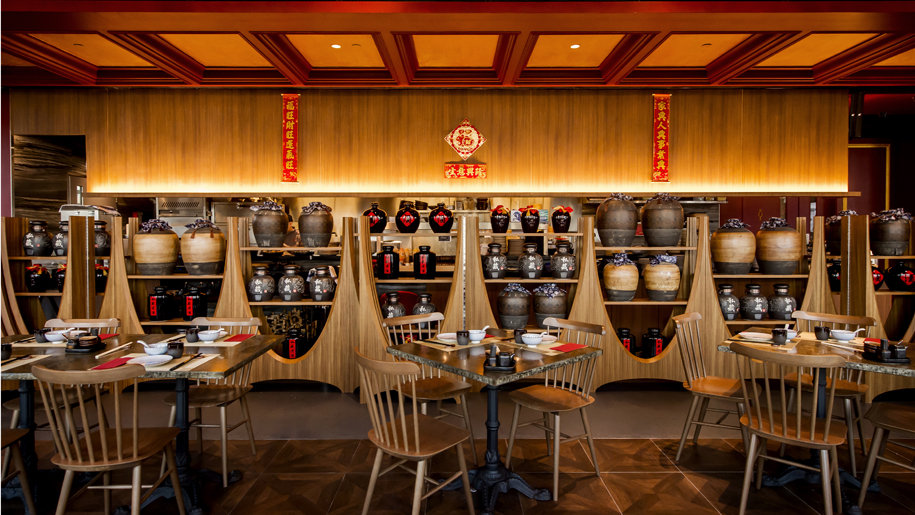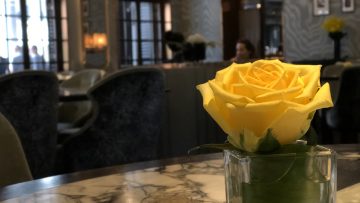
Background
Opened in mid-January 2019, Redhouse is the sister restaurant of Shè, which Business Traveller Asia-Pacific reviewed previously. Redhouse features “modern Chinese cuisine that is rooted upon authenticity instead of traditionalism”. Compared with Shè, it has a more extensive menu with more options of roast meats, premium seafood dishes, and dim sum.
Where is it?
In Lan Kwai Fong, the bustling nightlife hub of Hong Kong’s Central district filled with bars, clubs and restaurants. It’s easily accessible by MTR via Central Station: Get off at Exit D2, go across Queen’s Road Central and climb up D’Aguilar Street. Then you will see the 27-storey California Tower on the left. Redhouse is on the 23rd floor.
What’s it like?
As its name suggests, the design of Redhouse is inspired by the symbolic red colour in Chinese culture, representing vitality, joy and prosperity. This colour scheme can be seen almost everywhere from the red chairs, mosaic tables and wallpaper, to the fai chun (spring couplets), a traditional decoration used during Chinese New Year adorned with phrases wishing prosperity and good luck.
There’s a wine cabinet that separates the dining area from the open kitchen. The traditional Chinese wine jars add an ancient Chinese atmosphere to the interior space.

The restaurant has a bar area serving beer, wine, spirits, cocktails and snacks. There’s also a terrace near the bar, but it’s rather small. Meanwhile, located at the upper floors of California Tower, Redhouse has an impressive city view overlooking Central district.

The food
I began the meal with some dim sum, starting with some crispy taro puffs with foie gras, pork, and dried shrimp. The dish was creatively presented, looking like a group of adorable swans swimming in a lake.

Next came rose gold har gao. What distinguished it from prawn dumplings I’d eaten before – and made it more beautiful and appetising — was its pink tint, which comes from beetroot.

Then I had the steamed rice flour rolls with fresh scallops, which had a similar pink tint. I was a bit surprised because in Hong Kong, it’s more common to see steamed rice flour rolls made with BBQ pork, minced beef or prawn.

After the dim sum, I moved on to some small bites: the stuffed eggplants in teriyaki sauce and the crispy Bombay duck fish with salt and pepper. I enjoyed the latter better, despite generally not being a fish person: I usually can’t stand the smell and innumerable little bones that evoke a fear of joking. But the spicy flavour made it more appetising to me, and the boneless fish was so tender that it melted in my mouth.


These were followed by the double-boiled chicken soup with fish maw, coconut and cordyceps flowers. The soup, which tasted sweet and comforting, was made with the black meat of Silkie chicken, which is known for its fluffy plumage and has long been considered a curative and nourishing food in Chinese culture. And it was served hot in a coconut shell, so I could also eat some coconut fruit.

Next came the Peking duck. Besides the traditional way of offering shredded duck meat, crispy duck skin and other side dishes to be placed in flour wraps, I was also served a bowl of shredded duck crispy rice in supreme broth.

For mains, there were a variety of signature dishes inspired by different regions. I tried five main courses. First, I had the three-cup chicken in stone pot, a signature dish from China’s Jiangxi Province.

Then came a spicy dish: poached Wagyu beef slices in chili oil.

Followed by stir-fried string bean with minced pork and Chinese preserved vegetables.

The next dish was steamed pork patty topped with abalone.

And finally, the chili crab served with mini toasted buns. The crab was quite large and there was a lot of meat inside. It was a bit messy to eat and you need to eat it with a crab cracker; there’s a risk of the gravy splattering everywhere.

For desserts, I tried the Yin Yang style sponge cake first. It was creatively presented in the Chinese Yin Yang pattern with slices of two different colours of cakes representing two flavours: the yellow slices feature the original flavour, while the black ones are black sesame flavoured.

I also tried the Redhouse Signature Pearl. It was actually a jian dui (sometimes referred to as sesame ball), a type of fried Chinese pastry made from glutinous rice flour. Unlike the normal sesame balls that are usually the size of a fist, it was much larger and looked like a lamp from a distance. While I was wondering where to start eating it from, a waiter began cutting it from the top into several small slices. It tasted crispy and sweet.

The beverages
For non-alcoholic beverages, there is a series of signature fruit iced teas. I ordered the Papaya Mango Snow Fungus Iced Tea. I found it quite interesting because I’ve only ever seen snow fungus in main dishes, savoury soups and desserts, but never in a drink. The drink was less sweet than I expected, but rather refreshing. Meanwhile, some of my dining companions ordered the Apple & Osmanthus Iced Tea, and I noticed that it was topped with small slices of osmanthus cake, a traditional sweet-scented Chinese pastry made with glutinous rice flour, honey sweet-scented osmanthus and rock sugar.

The restaurant also has a special craft cocktail series called “The 7 Essentials Cocktail Series”, inspired by an old Chinese saying: “Seven necessities to begin a day”. Those seven necessities are firewood, rice, oil, salt, sauce, vinegar and tea. The cocktails are created with different spirits that are slow-cooked for three hours using a sous-vide technique with modern mixology.
For example, the Sauce cocktail is made of Chinese yellow rice wine, ginger juice, fresh lemon juice, pineapple juice, osmanthus syrup, King To Nin Jiom (a type of Chinese cough syrup) and fresh raspberry.

Verdict
Located in the heart of Hong Kong’s central business district, Redhouse offers a nice venue for those working nearby to have a decent business lunch, dinner or simply grab a drink. The food and beverage offerings show creativity and high quality. Meanwhile, its situation on the upper floors of a high-rise building allows you to avoid the street-level hustle and bustle of Lan Kwai Fong.
Fact file
- Hours: 11:30am – 11pm daily
- Price: Average spending is expected to be at HK$350-450 (US$44.59-US$57.33) per head, as advised by the restaurant. In addition, there is a tea or water charge of HK$15 (US$1.91) per person, plus a 10% service charge.
- Location: 23/F, California Tower, 32 D’Aguilar Street, Central, Hong Kong
- Contact: +852 2344 2366; gaiagroup.com/hk/restaurant/redhouse












